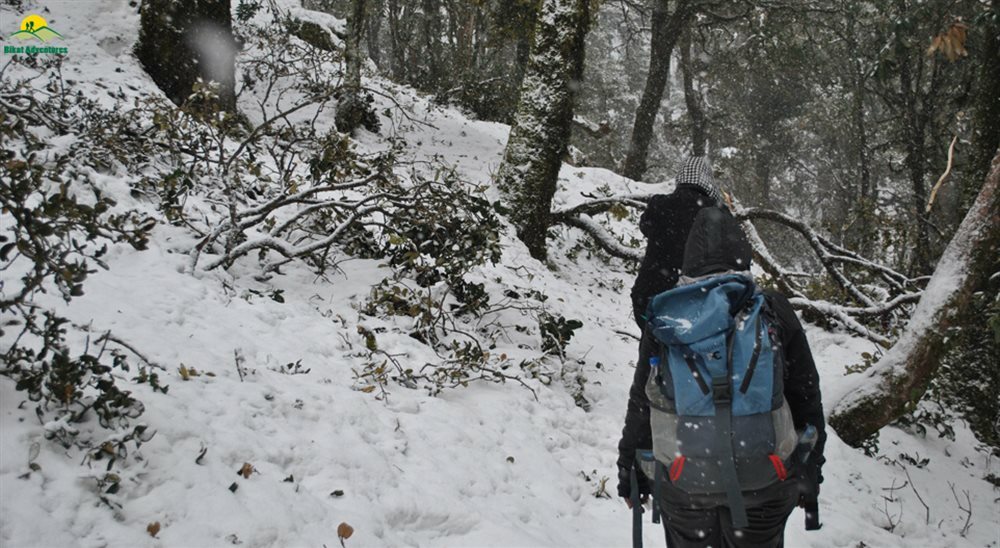 Nestled in the Garhwal Himalayas of Uttarakhand, the Nag Tibba Trek offers a breathtaking journey through diverse landscapes and stunning vistas. This comprehensive guide covers all aspects of the Nag Tibba trek, including its location, difficulty level, trek routes, the best time to visit, and what to expect along the way. Whether you're a beginner or an experienced trekker, this is your go-to resource for planning an unforgettable adventure.
Nestled in the Garhwal Himalayas of Uttarakhand, the Nag Tibba Trek offers a breathtaking journey through diverse landscapes and stunning vistas. This comprehensive guide covers all aspects of the Nag Tibba trek, including its location, difficulty level, trek routes, the best time to visit, and what to expect along the way. Whether you're a beginner or an experienced trekker, this is your go-to resource for planning an unforgettable adventure.
What is Nag Tibba Trek?
Nag Tibba, also known as the "Serpent's Peak," is one of the most popular weekend treks in Uttarakhand, offering a delightful mix of challenge and scenic beauty. It is situated at an altitude of 3,022 meters (9,915 feet) and is the highest peak in the Nag Tibba range of the Garhwal Himalayas. Known for its panoramic views of majestic Himalayan peaks such as Swargarohini, Bandarpoonch, Kedarnath, and Gangotri, Nag Tibba attracts adventure seekers from across the country.
Key Highlights:
Altitude: 3,022 meters (9,915 feet)
Location: Garhwal Himalayas, Uttarakhand
Difficulty Level: Easy to Moderate
Trek Distance: Approximately 19 kilometers (round trip)
Duration: 2-3 days
Where is Nag Tibba?
Nag Tibba is located in the Tehri Garhwal district of Uttarakhand, India. The trek usually starts from Pantwari village, which is approximately a 4-5 hour drive from Dehradun. This trek offers a quick and rewarding escape for those looking to explore the beauty of the Himalayas over a weekend.
How to Reach Nag Tibba
Reaching Nag Tibba is quite convenient, especially if you are starting from Dehradun or Delhi. Here's how you can plan your journey:
From Dehradun:
Distance: 90 kilometers
Travel Time: 4-5 hours by road
Route: Dehradun → Mussoorie → Kempty Falls → Pantwari
From Delhi:
First, travel to Dehradun by bus, train, or flight.
Then follow the same route from Dehradun to Pantwari.
Pantwari village serves as the base camp for the trek, and from here, you'll begin your journey on foot to the Nag Tibba summit.
Nag Tibba Trek Route
The Nag Tibba trek route is a well-defined trail that takes you through picturesque villages, lush forests, and rugged mountain paths. Here’s a typical itinerary for a 2-3 day trek:
Day 1: Pantwari to Nag Tibba Base Camp
Distance: 5.5 kilometers
Duration: 4-5 hours
Terrain: Cemented path, rocky trails, and forested sections
The trek begins at Pantwari village, with the initial 2 kilometers of walking along a cemented path through the village. As you progress, the trail becomes rockier and steeper, taking you through scenic farmlands and meadows. The final stretch of the day's trek leads through dense oak and rhododendron forests, culminating at the Nag Tibba base camp, where the famous Nag Mandir (Serpent Temple) is located.
Day 2: Nag Tibba Base Camp to Summit and Back
Distance: 4 kilometers (round trip)
Duration: 4-6 hours
Terrain: Steep ascent through forests and possible snow in winter
Day 2 starts with an early morning trek to the Nag Tibba summit. The path becomes steeper as you climb, and in winter, snow may cover much of the trail. The effort is well rewarded with stunning 360-degree views of some of the Himalayas' most prominent peaks like Bandarpoonch, Swargarohini, and Kedarnath. After enjoying the views from the summit, you will descend back to the base camp.
Day 3: Nag Tibba Base Camp to Pantwari
Distance: 5.5 kilometers
Duration: 3-4 hours
Terrain: Downhill trek through forest and village paths
The final day involves descending back to Pantwari village. The path is mostly downhill, offering a chance to appreciate the natural beauty at a more relaxed pace. Once in Pantwari, you can head back to Dehradun or extend your stay to explore more of Uttarakhand.
Best Time to Visit Nag Tibba
One of the best things about the Nag Tibba trek is that it is accessible almost year-round. However, each season offers a unique experience.
Winter (December to February)
Pros: Snow-covered landscapes, clear views of the Himalayas
Cons: Extremely cold temperatures, challenging terrain due to snow
Temperature: -7°C to 10°C
Winter transforms Nag Tibba into a winter wonderland, making it perfect for those seeking a snow trek. However, the trail becomes more challenging due to the snow, so proper winter gear is essential.
Spring (March to May)
Pros: Pleasant weather, blooming rhododendrons
Cons: Occasional rain
Temperature: 5°C to 22°C
Spring is a great time to trek if you enjoy mild weather and scenic beauty. The rhododendron forests are in full bloom, adding vibrant colors to the landscape.
Summer (June to August)
Pros: Lush green landscapes, clear skies
Cons: Potential for rain and leeches
Temperature: 15°C to 30°C
Summers bring clear skies and lush greenery to the region. Although the daytime can be warm, the nights are cool, making it a pleasant time for trekking. Be prepared for occasional rain.
Autumn (September to November)
Pros: Clear skies, excellent visibility, cool temperatures
Cons: Chilly nights
Temperature: 5°C to 20°C
Many consider autumn the best time to visit Nag Tibba, as the weather is stable, skies are clear, and the views of the Himalayan peaks are exceptional.
Nag Tibba Trek Difficulty
The Nag Tibba trek is considered easy to moderate in difficulty, making it an ideal option for beginners or families. The total trek distance is around 19 kilometers, and the highest point is at 3,022 meters. However, the trek does involve some steep sections, especially as you approach the summit.
Factors Affecting Difficulty:
Altitude: At 3,022 meters, altitude sickness is usually not a concern for most trekkers, but it’s still important to pace yourself.
Terrain: A mix of rocky paths, forest trails, and some steep climbs.
Weather: Winter treks are more challenging due to snow and cold temperatures.
Physical Fitness: While no special training is required, a moderate level of fitness is recommended.
Nag Tibba Trek Package
If you’re planning your trek, several companies offer Nag Tibba trek packages that typically include:
Transportation from Dehradun to Pantwari and back
Meals during the trek
Camping equipment (tents, sleeping bags)
Trekking guide
Forest permits and camping fees
These packages range between ₹4,000 to ₹8,000, depending on the duration, inclusions, and season.
Nag Tibba Trek Booking
To ensure a smooth trek, it’s advisable to make your Nag Tibba trek booking in advance, especially during peak trekking seasons. You can book through various trekking companies or local tour operators online.
Booking Tips:
Compare different trek operators and read reviews.
Understand the inclusions of your package.
Check the refund and cancellation policies.
Ensure the company follows safety protocols.
Confirm if the trekking gear (tents, sleeping bags, etc.) is provided.
Nag Tibba Solo Trek
For the adventurous, a solo trek to Nag Tibba is possible, but it comes with additional risks. Here’s what you need to keep in mind if you’re trekking solo:
Inform someone about your plans and expected return date.
Carry a map and familiarize yourself with the route.
Be well-prepared with the right gear, especially in winter.
Carry a first-aid kit and know basic first aid procedures.
While trekking solo offers freedom and solitude, it's highly recommended to go with a guide, especially if it's your first time trekking in the region.
Nag Tibba Mountain
The Nag Tibba mountain stands at 3,022 meters, making it the highest peak in the Nag Tibba range. It's called the "Serpent's Peak" because of the local belief that Nag Devta, the Snake God, resides here. The mountain plays a significant role in local folklore and offers a spectacular vantage point for viewing surrounding peaks like Swargarohini, Bandarpoonch, and Kedarnath.
Nag Tibba Temple
On your trek, you’ll come across the Nag Tibba Temple, a small temple dedicated to Nag Devta. Situated near the base camp, many trekkers stop here to pay their respects before continuing to the summit. The temple is of spiritual significance to the local villagers, who offer prayers to ensure protection and good harvests.
Nag Tibba View
One of the highlights of the Nag Tibba trek is the stunning view from the summit. On a clear day, you can see:
Bandarpoonch Peak
Swargarohini Peak
Gangotri Range
Kedarnath Peak
Chanabang Peak
The summit also offers spectacular sunrise and sunset views, making it a favorite among photographers and nature enthusiasts.
Nag Tibba in January
Trekking to Nag Tibba in January is a magical experience as the trail is covered in snow. While the trek becomes more challenging, the reward is a serene winter landscape. However, be prepared for:
Heavy snow cover on the trails.
Extremely cold temperatures, especially at night.
The need for proper winter gear, such as warm clothing, waterproof shoes, and trekking poles.
The winter season offers crystal-clear views of the snow-capped peaks, but it’s advisable for those with prior trekking experience.
Nag Tibba Trek Guide
While it's possible to complete the trek without a guide, having an experienced Nag Tibba trek guide can significantly enhance your experience. A local guide will:
Ensure your safety and navigate the trail efficiently.
Provide insights into the local flora, fauna, and culture.
Help you with acclimatization and monitor for altitude sickness.
Handle emergencies and provide first aid if needed.
Nag Tibba Trek Temperature and Weather
The Nag Tibba trek temperature and weather can vary significantly depending on the time of year. Here’s a general overview:
Winter (December-February): -7°C to 10°C, with heavy snowfall in January.
Spring (March-May): 5°C to 22°C, pleasant temperatures with blooming flowers.
Summer (June-August): 15°C to 30°C, warm days, cool nights, and potential rain.
Autumn (September-November): 5°C to 20°C, clear skies, and chilly nights.
Always check the weather forecast before starting the trek and be prepared for sudden changes, especially in the mountains.
Conclusion
The Nag Tibba Trek is a perfect blend of adventure, natural beauty, and cultural experience. Whether you’re a beginner looking for your first Himalayan trek or a seasoned trekker seeking a quick weekend escape, Nag Tibba offers something for everyone. Its accessibility from Dehradun and Delhi, coupled with its breathtaking views and diverse landscapes, makes it a must-visit destination for trekking enthusiasts.
By following this comprehensive guide, you’ll be well-prepared to tackle the Nag Tibba trek, ensuring a safe, enjoyable, and memorable experience amidst the pristine beauty of the Garhwal Himalayas.
